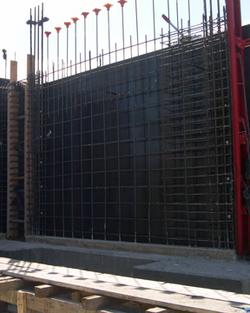|
November 22, 2005 -- In a first-of-its-kind earthquake test, UCSD engineering researchers on Nov. 22 subjected a 275-ton, seven-story building to mechanical shakes that duplicated ground motions recorded during the Jan. 17, 1994, Northridge earthquake. The test was the first in a series of tests aimed at evaluating a variety of promising new designs that might improve the earthquake safety of apartment and condominium buildings and other residential structures in densely populated and seismically active regions in Los Angeles and Southern California.
Several months ago, workers used tall cranes and heavy equipment to construct the 65-foot-tall building at the Jacobs School of Engineering’s EnglekirkStructural Engineering Center, which is about 8 miles east of the university’s main campus. Such a full-scale test had never before been possible because of weight, space, and technical limitations of smaller indoor shake tables.
The Nov. 22 test was designed to measure the performance of vertical reinforced concrete structural walls during strong earthquakes. In most of Southern California, structural walls are required by building codes to be strong enough to support about 30 percent of the building’s total weight. However, the test building at UCSD included a wall with half the required amount of reinforcing steel in an optimized layout, which offered a high degree of seismic safety for a fraction of the construction cost
“Our computational analyses suggest that shear walls could be designed with significantly less reinforcing steel and still protect life and property during rare, but strong earthquakes,” said José Restrepo, a professor of structural engineering at the UCSD Jacobs School of Engineering and co-principal investigator of the project. “It may be that we are over-designing some of our buildings with expensive reinforcements that may actually provide very little increase in seismic safety.”
The Nov. 22 earthquake test, which is being supported by a consortium of California engineering and design companies, is an outgrowth of the Jan. 17, 1994, earthquake that resulted in 60 deaths, more than 7,000 injured, 20,000 homeless, and more than 40,000 buildings damaged in Los Angeles, Ventura, Orange, and San Bernardino Counties. There was about $40 billion in property damage.
 |
| Reporters witnessed the dramatic shake test on Nov. 22 at the Englekirk Center. |
That quake, centered at Northridge, prompted a call by professional structural engineers for more scientific testing of shear walls and other structural elements of mid-rise residential buildings. “Many people don’t realize that excessive building strength can actually promote poor structural performance and non structural damage during an earthquake,” said Robert Englekirk, founder of the center and a co-principal investigator of the project. “The structural engineering community wants to develop regional design procedures that allow for the development of more suitable buildings in Southern California.”
The building shaken by UCSD researchers is much lighter and less costly to construct that current mid-rise California residential buildings because it has less steel and a smaller foundation. “Our analysis predicts that this lighter building would actually perform better in an earthquake than a heavier structure,” said Restrepo.
UCSD engineering researchers plan to build three additional full-scale, steel-reinforced concrete buildings to evaluate other seismic safety systems.
Construction of the seven-story building was made possible through financial support and donated equipment and labor from Southern California structural engineering and construction firms, including Associated Ready Mix, Baumann Engineering, California Field Ironworkers, Cemex, Concrete Reinforcing Steel Institute, Douglas E. Barnhart, Inc., Englekirk & Sabol, Inc., Fontana, Grace, Hanson Aggregates, Highrise Concrete Systems, Inc., Morley Builders, Pacific Southwest Structures, Schuff Steel-Pacific Inc., Southern California Ready Mix Concrete Association, the Portland Cement Association, and Carpenters/Contractors Cooperation Committee, a nonprofit labor and management group.
The 25 ft. by 40 ft shake table was constructed in September 2004 as part of the National Science Foundation’s George E. Brown Jr. Network for Earthquake Engineering Simulation (NEES). The $9 million shake table is the largest in the U.S. and the only outdoor shake table in the world, which makes it ideally suited for testing tall, full-scale buildings. Powerful hydraulic actuators can shake a test structure at speeds up to 6 feet per second, a speed that can reproduce near-fault ground motions, creating realistic simulations of the most devastating earthquakes ever recorded. The facility was funded through a grant from the National Science Foundation as well as state, university, and private contributions. Construction of the Jacobs School of Engineering’s EnglekirkStructural Engineering Center and the earthquake research program there is supported by the Englekirk Center Industry Advisory Board, a group of 45 structural engineering firms and associations in Southern California. Patron members include Carpenters/Contractors Cooperation Committee and
 |
| "Shear walls" are required by California building codes to be strong enough to support about 30 percent of the building’s total weight. However, the test building at UCSD included a shear wall with half the required amount of reinforcing steel, which enabled the building to flex during the test rather remain more rigid. |
Englekirk Systems Development, Inc. Other members include: American Segmental Bridge Institute; Anderson Drilling; Baumann Engineering, Brandow & Johnston Associates; Burkett and Wong Engineers; Charles Pankow Builders, Ltd.; Clark Pacific; Douglas E. Barnhart, Inc.; Dywidag Systems International, USA, Inc. (DSI); Englekirk and Sabol Consulting Structural Engineers, Inc.; EsGil Corporation; GEOCON; Gordon Forward; Highrise Concrete Systems, Inc.; HILTI; Hope Engineering, Inc.; John A. Martin and Associates; Josephson Werdowatz & Associates Incorporated; JVI, Inc.; KPFF Consulting Engineers; Matt Construction Corporation; Morley Builders; Nabih Youssef and Associates; Oak Creek Energy Systems; Occidental Petroleum Corporation; Pacific Southwest Structures; Parsons, PCL Construction Services, Inc.; Portland Cement Association; Precast/Prestressed Concrete Manufacturers Association of California (PCMAC); Rudolph and Sletten; Schuff Steel-Pacific, Inc.; Saiful/Bouquet Consulting Structural Engineers, Inc.; Structural Engineering Association of Southern California (SEAOSC); Simon Wong Engineering, Simpson Manufacturing Co., Inc.; Smith-Emery Company; Stedman & Dyson Structural Engineers; The Eli & Edythe L. Broad Foundation; Twining Laboratories; UC San Diego Design and Construction; Verco Manufacturing Co.; and the Structural Engineering Association of San Diego (SEAOSD). |




